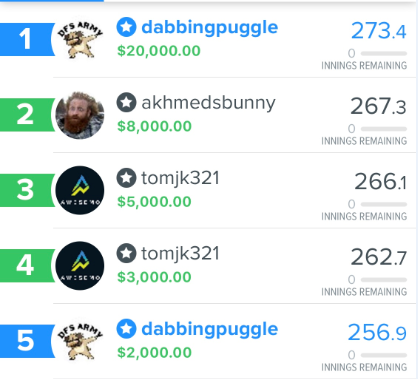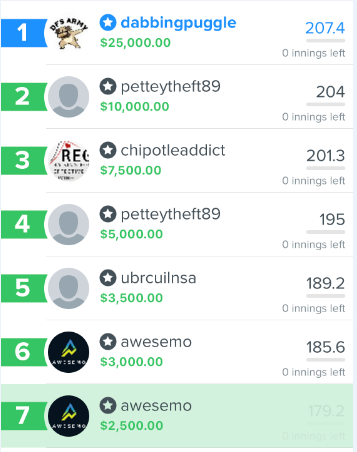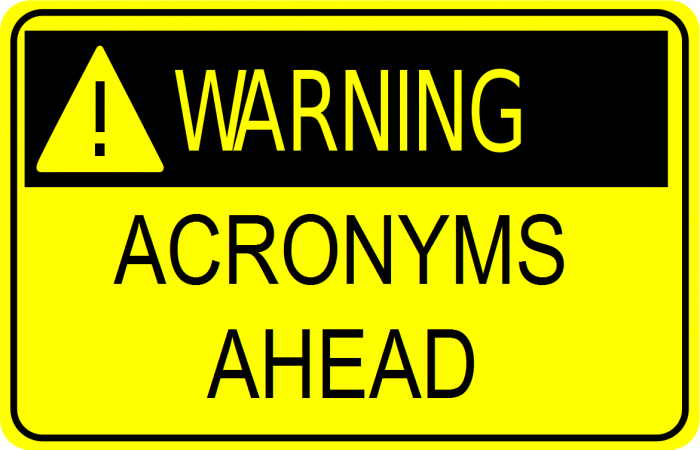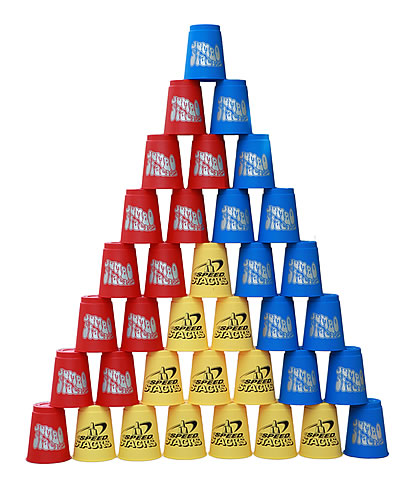


Welcome back my friends, to the game that never ends…I’m so glad you could attend, pick a side, pick a side! There are two sides in this DFS world we all love. Winners, and losers. I came to DFSArmy because I like to win, and that’s what we do here. The coaches here are proven winners… not this “I’m picking NFL games and College Football this season at 66% and you can get access for JUST $599 for 6 months” type of crap. You know the deal, you don’t want to be a sucker, you’re reading this then you picked the right side… the winning one. So let’s get to work!
GPPS, MMES, and other acronyms

GPP stands for Guaranteed Prize Pool. These are the featured tournaments on Fanduel and Draftkings that got you into DFS in the first place. It’s the big prizes, the bragging rights and the immense frustration that comes with getting close to winning… but no cigar. Stay with me awhile though, I’m going to teach you how to win them
MME stands for Mass Multi Entry. This is a term you’re going to need to know, because if you’re not mass multi entering your GPP’s then you’re probably burning money. Tournaments allow for individual users to enter more than one lineup, in the large fields… 150 lineups is the maximum. It is also my strong opinion that it should be the minimum for anyone who plays them. This brings me to my first analogy of many for the piece.
Consider playing tournaments in DFS to be like playing a game of darts. First place is the bulls-eye. The best players in the world should be able to hit this bulls-eye whenever they want, they’re the best. They have more experience, skill, and 100/100 times they will beat you in a straight up game of darts. However tournaments are more like extreme darts, where in order to have a shot at that bulls-eye you need to run through some sort of Bosnian obstacle course and fire your shot through 20,0000+ people and be more accurate than them.
So, you the reader are the best player in DFS. You’re so good that everybody knows your name…. and I suck. I am a trust fund baby who thinks Mike Trout and Tim Salmon are somehow related. We both enter the same tournament, except since I’m a trust fund baby, I enter it 150 times, and since you’re so damn good, you enter it once. Guess what… I’m going to beat you. You couldn’t beat me if your dart had a honing device on it, because my 150 darts are going to knock yours out of the way.
Even if you’re throwing ten or twenty darts… the reality is you’re throwing them against a ton of guys who have advanced predictive models and are using 150 lineups. So if you can’t enter the maximum amount of entries, you shouldn’t be playing these contests. There are plenty of other ones, at other buy ins, single entries, 20 max entries… Do not create a competitive disadvantage for yourself.
STACKING

Stacking is important in baseball because of the correlation players have to one another. Focusing on teams and a couple of batters is considerably easier than trying to identify eight or nine great individual performances. My personal preference is to stack a 4-4 or a 4-3 on most slates with the number representing the amount of players from one team. Now, not all stacks are created equal, simply going into the DS locking Nolan Arenado and running a whole bunch of Rockies 4 stacks is a good way to lose money. Instead, you want to focus on correlation within the lineup, making sure that the gaps between batting order does not exceed 2/3 places. If you run a stack with the 1-4-6-9 batters, you’re not giving your stack the same perceived positive correlation as using the 2-3-4-7 batters. The 9 batter could never get to the plate with all 3 of those hitters on base, while the stack with the 7 hitter could. Is it a must, no. Is it suggested, yes.
Let’s pause…. I’m long winded and I don’t want this to look like algebra to you. Adding numbers and big words like “perceived positive correlation” can get confusing quickly, so make sure you understand before we proceed. If you don’t, go ask a coach and come back.
Now that we have an idea of what stack correlation means, let’s talk a little bit about whether to use a 4-4 or a 4-3 or even a 4-2-2. The truth is, all are viable but the looser the stack the more volatile your results will be. Can you score more points by stacking more loosely? Yes. Can you go broke doing it? Yes. If you’re a beginner stick to the 4-4 until you feel more confident and have a better grasp on how to identify hitters in great spots. If you choose to employ a 4-3 stack or have in the past, you’re probably making a mistake that I did myself for a long time. I corrected this mistake and was a top 50 MLB tournament player in the industry last season.
Who is the batter by himself? It can never be who the DS is filling in for you, randomly slotting someone in because they “fit” is a lose money concept and you’re donating to the sharks. This hitter needs to be someone toward the top of the lineup who can produce independent of their teams success. I love lead off guys for this coveted spot in my 4-3-1 because they get more at bats and therefore more opportunity to produce. Another good quality this spot can have is power, if Chris Davis hits one into orbit and the Orioles lose 7-1 it’s still very possible using him can win you a tournament. I don’t care that he was hitting 8th and strikes out more than a guy with body odor at the bar, I care that he can hit the long ball. Two years ago, I was donating money by not paying close enough attention to who I used solo or even in a 2 stack when I wanted to take that approach. Making this simple change drastically improved my cash and win rate because I fine tuned that area of my game. Orlando Arcia, Jackie Bradley Jr… these weak power options hitting in the bottom part of the order, you can use them in a stack, but stop using them because they “fit”.
Who do we stack? Well, Vegas isn’t often wrong people, but the worst teams in baseball are still going to win 1/3 of their games. Sticking to high run totals is normally a profitable way to approach DFS, but for tournaments it is not always the best strategy. You can’t just use the Yankees, Red Sox, and Coors teams nightly. You have to mix them in with other teams in good spots (which we’ll talk about in a bit). Taking the top 5-6 projected teams for the night and only stacking them is not going to win you a tournament. It is also very difficult to get nicely correlated stacks that way because the top teams and their stars are usually priced that way which forces you into poor correlation because you wanted to feel good about having the Yankees and the Dodgers in your lineup that night. What good does that do if the lineup has 5 batters hitting 7th or lower on it? Don’t be a hero, be a nerd.
Example: Last season I took down a GPP by using the White Sox who were virtually unowned. I was able to stack the heart of their lineup in a game they were projected to score just about 4 runs. I said “Puggle, if they can get to 7, pairing them with monster like the Yankee’s allows me to have Judge, Stanton, and keep the stack correlated…. that could definitely win.”
Ownership matters and one way to get it is by using a slightly contrarian stack with a popular one. Don’t get too contrarian and start stacking the Marlins and the Giants together on a nightly basis, that’s not going to work out well for you. Quickly touching on why ownership matters, let’s say for example Mike Trout has good game and you used him. Well, you and 20-30% of the field are all moving forward at the same time which is fine, but it’s those guys who you roster that are sub 5% ownership that separate you from the pack.
Another place we can find ownership is with our old friend batting order. Top of the order represents more opportunity and generally more ability for performance from the batter. Bottom of the order represents to a lot of people, less ability and less opportunity. I look at the bottom of the order and I see ownership. If I can find a few key guys nightly to dial in on there and they have a big night, I should have a big night as well. Hypothetically a guy like Brandon Guyer who has never been an everyday player but mashes lefty pitching can offer me upside at a low price and even though he’s batting 8th can prove some value by using him in a 4 stack of the 3-5-6-8 batters because he can very easily knock those 5-6 guys in. You don’t need a lot of these guys on your team to vault you to the top of a GPP, but it’s yet another way to be different while still being positively correlated to the stack.
Hedging

Let’s talk briefly about the concept of hedging. Hedging a parlay is often pretty stupid. I mean you bet $100 to win $600 but now you’re willing to settle for $400. Why would you do that… if you wanted to win $400 you should of just put in a parlay with less teams. You could argue you take the guaranteed money, but I would argue right back that nothing is guaranteed until the last out is recorded and that without risk, there is no reward. Speaking of parlays… we have an incredible team working over here at https://wp.dfsarmy.com/beat-the-bookie . Check em out!
We have 150 teams to work with here. We’re going to be taking some risk, because Robbie Ray is pitching and he has double digit strikeout potential almost every start. However, he can also get smacked around like an amateur boxer in the ring with Mike Tyson. So this is a spot I want to hedge. I may use a ton of Robbie Ray, or any other high risk-reward pitcher… I’m also going to absolutely get shares of his opponent that night. By doing this I am hedging against my highest exposed pitcher so I ensure I don’t go broke on the night. Let me reiterate that I do not care to hedge against DeGrom, or Scherzer, or Chris Sale… when they are pitching against the bottom barrel type of teams. They are simply not going to be giving up six home runs and be out of the game in the 4th inning. It happens so infrequently that you’re wasting entries hedging against those stud pitchers. The times to use hedge stacks are when you’re using a lot of a guy like Dylan Bundy who can go 7 innings with 7 K’s or can go 3 innings and give up 7 runs.
Research

Research is important… familiarize yourself with the RS. It is without question the most intricate and comprehensive tool in the entire industry. Nothing really comes close to be honest with you, so learn it. https://wp.dfsarmy.com/2018/04/dfs-army-mlb-research-station-tutorial.html
You pay for this site, not using all of the tools here is like buying a whole chicken but only eating the white meat…. and for my vegan friends it’s like buying kale and then realizing you could be eating chicken but you made a strange life choice! Sorry vegans… wings are awesome.
Now, I could do this all damn day and night, but I want to simplify things for you. Statistics matter, baseball has a lot of them. It’s up to you to decide which of them you’d like to weigh more heavily, but below are some definitions of some of my favorite stats and charts to help you grade them. Keep in mind, these aren’t rules. If on a scale of 1-10 a 5 is average, that doesn’t mean just because a player rates as a 4 that they are not worthy of a spot in your lineup today. These are just guidelines to help you along and what I typically use when I research.
For Batters:
wOBA stands for Weighted On-Base Average and combines all the different aspects of hitting into one metric, weighting each of them in proportion to their actual run value. While batting average, on-base percentage, and slugging percentage fall short in accuracy and scope, wOBA measures and captures offensive value more accurately and comprehensively.
| Excellent | .400 |
| Great | .370 |
| Above Average | .340 |
| Average | .320 |
| Below Average | .310 |
| Poor | .300 |
| Awful | .290 |
wRC+ stands for Weighted Runs Created Plus and is the most comprehensive rate statistic used to measure hitting performance because it takes into account the varying weights of each offensive action (like wOBA) and then adjusts them for the park and league context in which they took place.
| Excellent | 160 | |
| Great | 140 | |
| Above Average | 115 | |
| Average | 100 | |
| Below Average | 80 | |
| Poor | 75 | |
| Awful | 60 |
ISO stands for Isolated Power and is the average number of extra bases per at bat, calculated several ways such as SLG minus AVG. This is my favorite statistic as it is a great indication of power which is in my opinion the best source of points in MLB DFS.
| Excellent | 0.250 |
| Great | 0.200 |
| Above Average | 0.170 |
| Average | 0.140 |
| Below Average | 0.120 |
| Poor | 0.100 |
| Awful | 0.080 |
For Pitchers:
K/9 or K% and BB/9 or BB% should be used in conjunction with one another. Strikeouts are the primary source of points for pitchers and the larger the gap between their K rate and BB rate, generally the more effective they are. The following two charts are to be read from left to right with the first column in chart 1 being the K/9 and the second column being K%. The next chart being BB/9 and BB%,
| Excellent | 10.0 | 27.0% |
| Great | 9.0 | 24.0% |
| Above Average | 8.2 | 22.0% |
| Average | 7.7 | 20.0% |
| Below Average | 7.0 | 17.0% |
| Poor | 6.0 | 15.0% |
| Awful | 5.0 | 13.0% |
| Excellent | 1.5 | 4.5% |
| Great | 1.9 | 5.5% |
| Above Average | 2.5 | 6.5% |
| Average | 2.9 | 7.7% |
| Below Average | 3.2 | 8.0% |
| Poor | 3.5 | 8.5% |
| Awful | 4.0 | 9.0% |
While there are other advanced pitching stats that can be helpful, I would rather touch on more on our friend in Vegas. Betting odds and projected run totals are important not only because they give us an idea of who is projected to score the most points for an offense, but also what pitchers could score the most points. While a pitcher could have a poor K rate, they may be only projected to yield 3.7 runs that evening due to a weak opponent. They are still absolutely in consideration. I personally like to narrow down my pitchers for the night by checking off three different boxes.
A K/9 over 8.
A home favorite.
An opposing team run projection less than 4.25
While I may not always adhere to these “rules” it is a quick and easy way to locate your pitchers to consider using on any slate.
THE SECRET SAUCE

I get a lot of questions to the effect of “What’s your secret?” Well…. there is not one. I don’t have secrets, I have my process, my model, and most importantly. I have a strategy. Game theory is something that can be extremely important in DFS tournament approach.
Real definition: Game theory is the study of mathematical models of strategic interaction between rational decision-makers. It has applications in all fields of social science, as well as in logic and computer science. Originally, it addressed zero-sum games, in which one person’s gains result in losses for the other participants….
My definition: The Rockies are projected to score 6.5 runs tonight at home. They will be chalk. Is their spot good? Yes, best on the board by a mile. Is this baseball and can anything happen? Yes… that’s why this awful Orioles team is still going to win 50 times this year. What can I gain by rostering most of my teams with Rockies bats? Well, If they score the most points I’m going to need them to win tonight, so I should definitely use them. Yeah… eat the chalk sometimes. What can I gain by rostering Oriole bats? It’s risky but they have a poor opponent in an extremely good hitting environment, if they score the most runs tonight, not only will I need them to win, I am putting myself in a great position getting points from a team that many won’t be stacking. Is it a real possibility that they can score 8-9 runs, yes. It may not be the most probable, but it’s completely possible.
FANDUEL ONLY
We have a utility spot here. Please dear god stop using the utility spot for a 2nd shortstop. They don’t hit home runs. Unless you managed to get an Astros-Indians stack with Correa and Lindor, you’re making a bad lineup. I see so many teams that look like this.

This is a waste of an entry. You should not be forcing low upside plays into your lineup because you “had to have Blackmon and Arenado.” I like to keep my utility spot for 2 positions. First and Third base. They are traditionally the best sources of power along with corner outfielders as well. I will say it one final time for people that skimmed this article like I didn’t spend hours of my time putting it together to help you….. POWER EQUALS POINTS. The middle infield positions typically lack power upside. Why roster more of them than you have to?
That’s it for now… the game is always evolving and so should you as a player. Don’t get stuck on one thing and let it cloud your judgement. Be flexible, but be concentrated. Most importantly… play within your bankroll. Gus Hansen is one of the best poker players in the last twenty years but has gone broke so many times. Be patient, your time will come and if you put in the work, I’ll see you in some of the tournaments I like to play… just make sure you’re okay with taking 2nd place if I’m in it!
